Electromagnetic Pulse (EMP) – What You Need to Know
![]()
ByAugust NevermanAugust 23, 2022
The two most likely reasons for an EMP are a nuclear explosion or solar flare. This post discusses the damage an EMP may cause and actions that you can take to prevent or manage the results of the EMP. A large Electromagnetic Pulse EMP would cause widespread problems.
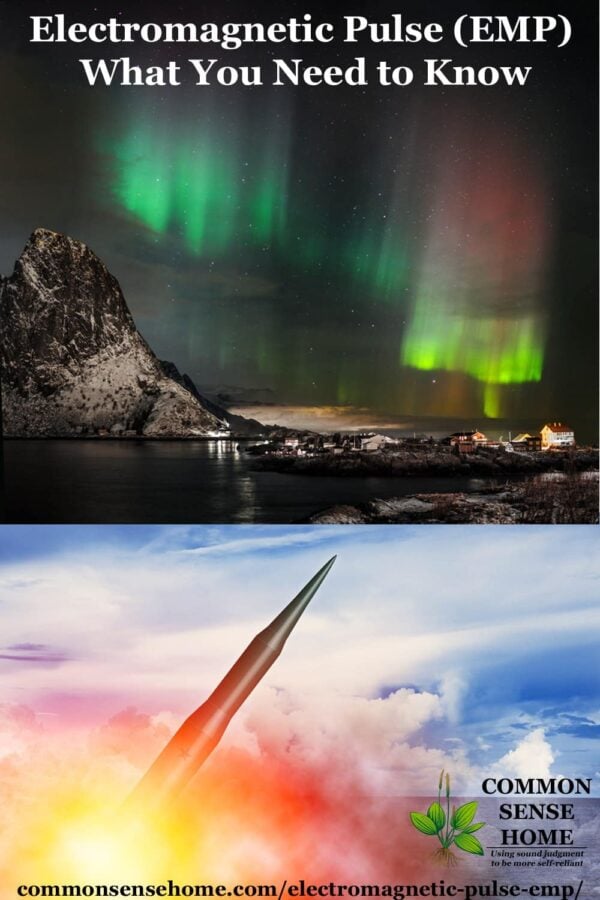
This post is part of our Common Sense Preparedness series, where our goal is to help you be prepared for whatever life throws at you.
Contents [Hide]
- What is an EMP (Electro Magnetic Pulse)?
- What causes an EMP?
- What could an EMP damage?
- What is the difference between Solar and Nuclear EMP?
- Nuclear EMP Summary (High Altitude EMP)
- How long would it take to recover from Nuclear EMP?
- What is a Solar Flare?
- Protect Devices from an EMP
- How to prepare for an EMP?
- Preparing for a small EMP
- Related articles:
- Preparing for a large EMP
- What You Need to Do – For EMPs and Other Large Disruptions
- References
- Related Posts
0 of 3 minutes, 9 secondsVolume 0%
What is an EMP (Electro Magnetic Pulse)?
An EMP or Electro Magnetic Pulse is a wave of electromagnetic radiation. It is like sunshine or a bright flash but on a different frequency.
The electrons from an EMP rains down on the plant. Those electrons interact with power lines, metal, conductive materials and electronics and causes power spikes. A large EMP could knock out power or damage or destroy electronic equipment.
Most EMPs do not directly hurt people, although they may cause harm when produced in extreme conditions such as munitions explosions.
What causes an EMP?
An EMP can be caused by many things. The two most likely EMP threats are a nuclear explosion or solar flare.
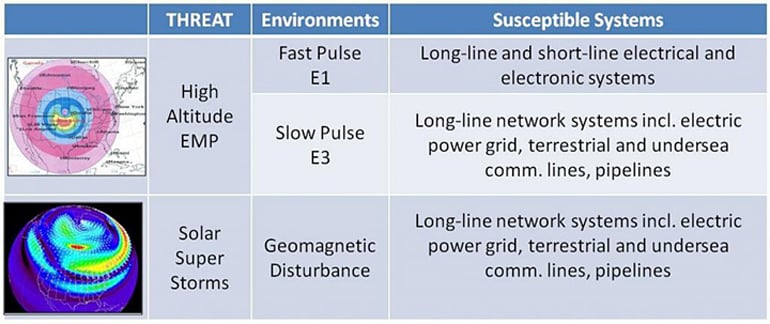
What could an EMP damage?
Depending on the power of the explosion or solar flare, an EMP could disable, damage or destroy:
- TVs, radios and other broadcast equipment
- Power grid transformers and substations
- Telephones (land lines) and smartphones
- Vehicle and aircraft control systems
- Computers and all internet connected devices
- Refrigerators
- Generators
- Satellites potentially within the range of the EMP
Anything electronic or powered by electricity could be damaged by an EMP. The damage will vary with the size of the EMP and how close you are to the center of the energy from the EMP.
What is the difference between Solar and Nuclear EMP?
A nuclear EMP is a more energetic and has a shorter burst. A solar flare EMP may also be referred to as a Coronal Mass Ejection (CME) or a geomagnetic storm. Solar flares vary widely in intensity from simply causing bright “northern lights” to potentially destroying some or all of the power grid. Smaller EMPs may cause power grid blackouts. Solar flares can last much longer than nuclear EMPs.
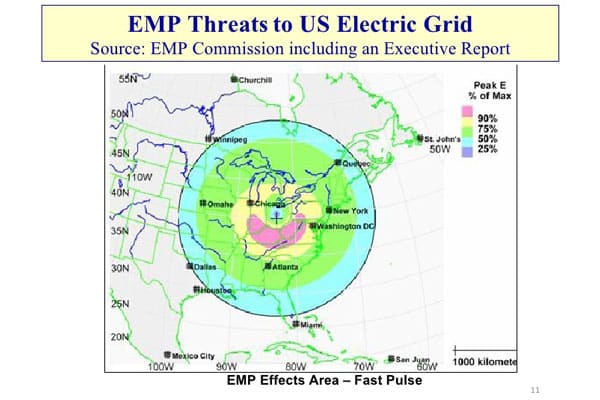
Nuclear EMP Summary (High Altitude EMP)
With the proliferation of nuclear weapons, the likelihood of a nuclear EMP increases. A nuclear EMP requires a nuclear weapon delivered by a rocket, high flying aircraft or ICBM. The nuke is detonated high in the air (referred to as an “air burst” or atmospheric burst) to create the EMP.
In a worst case senario, the nuke is detonated in the upper atmosphere, approximately 20 miles up. A large 1 kiloton to 2 kiloton nuclear electromagnetic pulse like this would be very serious. A nation state or rogue state such as North Korea or Iran are the most likely cause of an atmospheric nuclear burst (EMP). There are other ways to create small directed EMPs but we are not covering them in this post.
How bad would the damage be?
The atmospheric nuclear explosion itself would create little to no physical destruction. The gamma radiation would be fairly far away so its direct impact would be limited. However, the air burst nuke would create a widespread EMP and some limited fallout.
That large nuclear EMP would destroy or at least damage the electrical grid (see below). It would also destroy electronics within the EMP area. Nearly all vehicles with electronic systems would fail when exposed to the EMP. With the level of damage depending on how close and how powerful the blast is. Of course the location and protection of the vehicle impact the level of possible electronics damage.
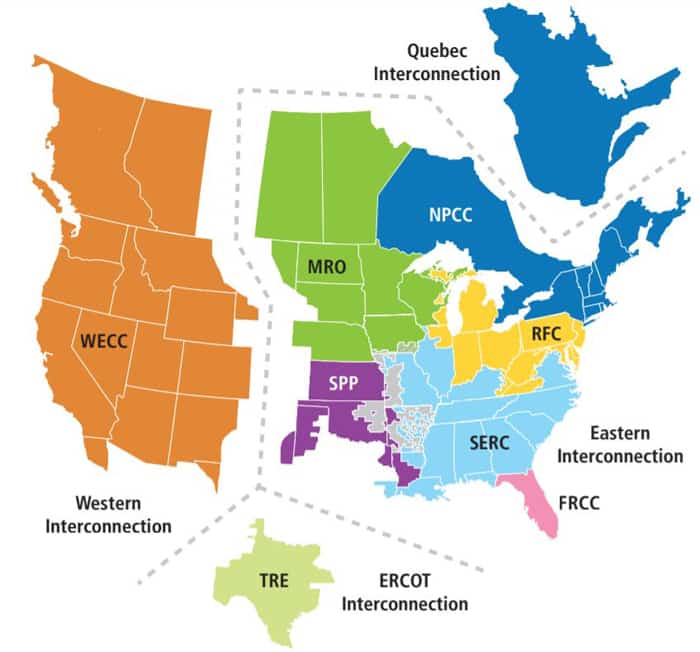
Basically, a fast burst, high energy nuclear EMP damages or destroys all nearby non-shielded electronic devices (cell phones, refrigerators, generators, inverters, TVs, radios, cars, etc) within its area of effect in a few seconds.
Note: In nuclear weapon tests the EMP doesn’t expand in simple circles. The earth’s magnetosphere deflects and interacts with the blast, causing the waves to spread more strongly away from the poles and may vary widely. The pulse is concentrated more strongly in a semi-circular band, as shown in the image above. The earths magnetic field deforms the explosion. The image below gives a rough idea of the interaction between the EMP and the magentosphere.

The graphic above is only an estimate – and would vary in the real world based on size of the weapon, altitude it was set to explode at, the atmospheric state, magnetosphere state and other variables.
Recent news:
- https://www.washingtonpost.com/politics/2019/03/29/trump-issued-an-executive-order-prepare-an-emp-attack-what-is-it-should-you-worry/
- https://www.energy.gov/articles/president-trump-signs-executive-order-resilience-against-electromagnetic-pulses
How long would it take to recover from Nuclear EMP?
The time to recover from an nuclear EMP could be hours, days, weeks, months or years. Recovery would vary depending on the scope, location, size and type of explosion, and altitude of the EMP attack. The scope of damage to the electrical grid and technology infrastructure nationally would be a big factor in recovery time. If the blast was small enough or far enough away, vehicles may be disabled temporarily but might be able to be restarted. There is no clear, easy way to predict impact, duration and scope of an EMP.
The biggest risk is a multi warhead nuclear EMP attack resulting in multiple atmospheric nuclear bursts. Multiple bursts spread out over the USA would likely cripple if not destroy the entire power grid. A total power grid failure would require months to even years of recovery work. If the power grid fails, water and natural gas also fail soon after the burst.
Could a surface nuclear blast cause an EMP?
A terrorist group would have trouble successfully setting off a high altitude air burst. It is more likely they would likely use a ship and float in a nuke to a major port city.
The lower altitude greatly restricts the range of the EMP damage. Unfortunately the proximity to the ground would increase local physical damage, gamma radiation and fallout.
A dirty bomb would tend to be devastating locally, but would not result in a widespread EMP. See also “Nuclear Radiation Exposure – How to Reduce Your Risks“.
Nuclear EMP Details
The amount of energy created in a nuclear EMP is difficult to calculate. We can estimate EMP energy based on historical nuclear tests. A nuclear test using a 1.47 megaton bomb was detonated in 1962, about 400 kilometers (250 mi) in the mid-pacific ocean. The test was called “Starfish Prime” . The nuclear detonation caused electrical damage in Hawaii between 800 to 900 miles away.
If the same 1.4 megaton nuke was detonated off the US, it is estimated it would have created a 22 to 30 kV/m pulse at the core of its blast. A modern hydrogen bomb is 3 kilotons all the way up to 1.2 megatons, so the amount of EMP from one of these would vary greatly. You can use the kiloton ratio to estimate the range of the EMP and impact in kV/m.
Aircraft may be impacted, but the metal fuselage would function partially as a Faraday cage. That means aircraft would not necessarily as susceptible, depending on proximity and many other variables.
The distance from the detonation, the altitude and the magnetosphere will determine the amount of damage to electronics. Ultimately the area in the blast would very likely see a regional electrical grid failure. A functional vehicle would not necessarily do you any good if the gas stations can’t pump.
EMP Proof Car?
Cars are more resilient than many other electronics. The car has a partial “faraday cage” because of the metal frame, which helps some, and the rubber tires isolate the vehicle from the ground. This protects the electronics to some extent.
If you are in a storm, if you had a power line hit your car STAY IN THE CAR. The tires isolate the power flow. Do not get out.
Getting out causes your body to create a ground route (a circuit) from the power line to the earth through YOU. This same protection helps you if there is a smaller EMP so all cars and trucks might not fail like in the movies.
The older the car or truck the less sensitive it would be to an EMP. A grounding unit (fuse) on the car battery would help, but will not eliminate the risk.
The problem is that a car still has a 12v positive and negative in the battery, an antenna for the radio and wiring. The electronics in a car or truck would likely survive .25 kV/m EMP blast (especially if it’s not running), but higher than .25kV/m would likely damage or destroy the electronics. The higher the kV/m (higher power EMP) means a higher likelihood of damage.
What is a Solar Flare?
A solar flare or Coronal Mass Ejection (CME) is created by the sun through normal activity results in electromagnetic radiation that travels through space. This type of EMP is normally less damaging to electronics but more damaging to the power grid.

https://www.nasa.gov/content/goddard/nasa-releases-images-of-mid-level-solar-flare/
Scientists can detect a coronal mass ejection (CME) and have time to issue a warning. It takes about 5 days for a CME to reach earth.
When a CME hits the earth it creates a geomagnetic storm or EMP on earth, also referred to as a Geo Magnetic Disturbance (GMD). Our magnetosphere protects us from most solar radiation and EMP effects. Although rare, larger solar flares get through the magnetosphere and impact the earths surface. The flares that hit the surface are the biggest theat.
Why is a solar flare dangerous?
A very large, extended Solar Flare EMP could destroy some or all of the high voltage backbone transformers, locally or globally. These transformers are critical to the U.S. electric grid. Even if only a few hundred of the larger transformers were destroyed it would likely disable the entire interconnected system for weeks, months or even years.
Small electronics could survive a solar flare, cell towers could, some cellphones may survive also. The bigger problem is the power grid damage. An extended Solar EMP is a big problem. In general a large long lived solar flare would be far worse than a single nuclear EMP, damaging or destroying satellites and the power grid.
You can get warnings and alerts for known solar flares on your computer or smartphone. Here are some references:
- Apple Solar Alerts Apps
- Google App Solar Alerts
- NWS Space Weather
- Flare Aware https://flareaware.com/
How long would it take to recover from Solar EMP?
The recovery time for small solar EMP could be days to weeks (like 1989 in Canada). The time to recover from a large solar flare EMP could be months to years. The effects of an EMP vary widely depending on the scope, weather, grounding, location, intensity and length of the burst.
The largest risk is damage to the electrical grid and technology infrastructure. A major EMP would not directly kill people but the resulting loss of power and communications would result in short and possibly severe long term impacts. It could also disable or destroy some satellites if the flare was strong enough. Although unlikely, a solar flare could also cause cars and trucks to stop working temporarily or permanently.
Largest Recorded Solar Flare in History
The largest recorded CME was the 1859 Carrington event. It lasted multiple days and impacted the entire planet. It caused telegraph wires in the United States to burst into flames, starting fires along the telegraph lines. Telegraph machines scorched paper printouts, gave operators electric shocks, and transmitted gibberish. Telegraphs continued working for hours even after being unplugged from the batteries that powered them.
For two days, the light show (northern lights) and electromagnetic storm continued, then faded. A repeat of this event would be disastrous to our electronics dependent modern environment, impacting part or all of the planet. The scope of a larger flare would be devastating.
NOTE: Scientists suspect that in 774AD there was a major flare referred to as the Miyake Event. The estimates are that it was 10x to 14x larger than the Carrington Event. As this cannot be 100% confirmed I list the Carrington as the largest recorded. The measure was based on carbon-14 tracking in trees.
7176 B.C. Solar Storm
There is evidence of a massive flare in 7176BC. Based on isotopes and radioactivity, scientists determined the 7176 B.C. storm was far worse than any recorded solar storm to date.
If that flare happened now it would completely disable satellites and the power grid. More info: https://astronomy.com/news/2022/03/ice-holds-evidence-of-ancient-massive-solar-storm
Recent EMPs
In 1979 there was a small solar flare that caused Toronto to be without power for an entire day. There was also a smaller flare that knocked out power in the entire province of Quebec in 1989. The odds of these events are hard to predict, but the likelihood is as high as 1 in 8 for the next 10 years (varying with the solar cycle).
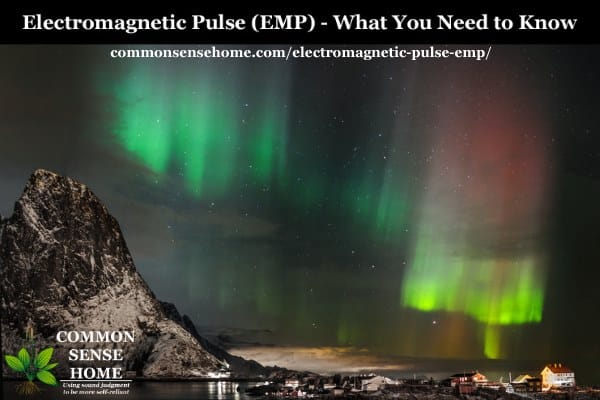
Protect Devices from an EMP
You can shield or protect devices by protecting them from the pulse or radiation. These are primarily for a nuclear EMP. Here are three ways:
- Build a Faraday cage (a shield that redirects power to ground) using a conductive metal container that is grounded.
- Ground a “shell” around them and isolating them from the electromagnetic radiation/power spikes
- Use industrial grade ground fault isolation will help from a grid feed issue but fuses and ground fault will not stop the electron flow from an EMP
5 basic EMP protection options (primarily for a nuclear EMP):
- Foil wrap: A simple Faraday cage can be made by COMPLETELY covering an object with aluminum foil. Wrap your radio with cloth or other insulation, then wrap that with a double layer of aluminum foil (to ensure no gaps). Ensure that this shell is well grounded (electrical ground).
- Garbage Can or other metal container: A large fairly cheap Faraday cage can be a steel garbage can with a couple of grounding rods. The steel of the garbage can interacts with the EMP and creates a voltage/current spike that is then grounded. That redirects the electrical charge, protecting the contents of the garbage can. A Faraday Cage can be used to store radios and other susceptible electronic devices.
- Metal Roof: A house with a extremely well grounded metal roof could protect from an EMP, because it could effectively “shield” the house by interacting with EMP and then re-directing the resulting voltage/current spike to the heavy ground wires (like lightning). A multi-day solar flare would create ongoing voltage/current. A nuclear explosion would create a spike more like a lightning strike, independently hitting everything within line of sight. Note: A grounded metal roof alone doesn’t fix the problem, because power line spikes could negate any benefits a metal roof would provide.
- Metal fencing to create a “box” or full “cage”. Then combine the cage with multiple grounding rods. Include a metal fence roof and ground all the panels or sections. The cage “catches” or absorbs the EMP (electron flow) and redirects the electrons to the earth. This type of setup allows for more storage.
- These items were designed specifically to shield from EMPs:
EMP Questions and Answers
Would a power strip protect my device from an EMP?
It would protect your device from a power spike from a power spike from the power grid, and help with a small EMP but it would not protect from a larger EMP. It would protect from power spikes, but not direct EMP radiation.
Does an EMP permanently destroy electronics?
Only if the EMP is large enough, and close enough and the device is not protected.
What is an EMP Gun?
A device that creates a short electromagnetic pulse or beam.
Is an EMP a real threat?
Yes. The odds are low though.
Is a solar flare or nuclear EMP more dangerous?
An EMP from a nuclear bomb is more likely than a super massive solar CME. If the CME were large enough and long enough it could take out all power grid sources in the world. A nuclear EMP would damage electronics in an area but not the entire planet.
How to prepare for an EMP?
The best course of action for most people is to focus on events such as a 72 hour power outage. Short duration trouble is more likely than long term problems.
It is possible but quite unlikely that a global event could occur due to: a solar flare, major meteor storm, pandemic, major volcanic activity, war or any number of other catastrophes. We suggest you plan for the far more likely small solar flare, snowstorm, power outage, tornado, earthquake or hurricane.
Prepare for likely short events first. Then if you have the resources and understanding, prepare for the less likely ones like a solar or nuclear EMP or a very large CME.
Preparing for a small EMP
Prepare like you would for a hurricane, tornado, earthquake or other extended natural disaster. The government recommends 72 hours of supplies. We recommend 7 days to start, 30 days as a target and your stretch goal of 1 year. Stockpile food and water, fuel, prescriptions, general medical supplies, personal hygiene items – the basics you need to survive. Use those stocks first in first out (meaning use the oldest first).
Plan for cooking, shelter, self defense, heating, cooling, clothing, hygiene, handling medical emergencies and garbage disposal as if you were camping without power. Having 72 hours to 1 year of food and supplies stashed can serve you regardless of the event, even as simple as a job loss.
Electromagnetic Pulse (EMP) – What You Need to Know
ByAugust NevermanAugust 23, 2022
The two most likely reasons for an EMP are a nuclear explosion or solar flare. This post discusses the damage an EMP may cause and actions that you can take to prevent or manage the results of the EMP. A large Electromagnetic Pulse EMP would cause widespread problems.

This post is part of our Common Sense Preparedness series, where our goal is to help you be prepared for whatever life throws at you.
Contents [Hide]
- What is an EMP (Electro Magnetic Pulse)?
- What causes an EMP?
- What could an EMP damage?
- What is the difference between Solar and Nuclear EMP?
- Nuclear EMP Summary (High Altitude EMP)
- How long would it take to recover from Nuclear EMP?
- What is a Solar Flare?
- Protect Devices from an EMP
- How to prepare for an EMP?
- Preparing for a small EMP
- Related articles:
- Preparing for a large EMP
- What You Need to Do – For EMPs and Other Large Disruptions
- References
- Related Posts
0 of 3 minutes, 9 secondsVolume 0%
What is an EMP (Electro Magnetic Pulse)?
An EMP or Electro Magnetic Pulse is a wave of electromagnetic radiation. It is like sunshine or a bright flash but on a different frequency.
The electrons from an EMP rains down on the plant. Those electrons interact with power lines, metal, conductive materials and electronics and causes power spikes. A large EMP could knock out power or damage or destroy electronic equipment.
Most EMPs do not directly hurt people, although they may cause harm when produced in extreme conditions such as munitions explosions.
What causes an EMP?
An EMP can be caused by many things. The two most likely EMP threats are a nuclear explosion or solar flare.

What could an EMP damage?
Depending on the power of the explosion or solar flare, an EMP could disable, damage or destroy:
- TVs, radios and other broadcast equipment
- Power grid transformers and substations
- Telephones (land lines) and smartphones
- Vehicle and aircraft control systems
- Computers and all internet connected devices
- Refrigerators
- Generators
- Satellites potentially within the range of the EMP
Anything electronic or powered by electricity could be damaged by an EMP. The damage will vary with the size of the EMP and how close you are to the center of the energy from the EMP.
What is the difference between Solar and Nuclear EMP?
A nuclear EMP is a more energetic and has a shorter burst. A solar flare EMP may also be referred to as a Coronal Mass Ejection (CME) or a geomagnetic storm. Solar flares vary widely in intensity from simply causing bright “northern lights” to potentially destroying some or all of the power grid. Smaller EMPs may cause power grid blackouts. Solar flares can last much longer than nuclear EMPs.

Nuclear EMP Summary (High Altitude EMP)
With the proliferation of nuclear weapons, the likelihood of a nuclear EMP increases. A nuclear EMP requires a nuclear weapon delivered by a rocket, high flying aircraft or ICBM. The nuke is detonated high in the air (referred to as an “air burst” or atmospheric burst) to create the EMP.
In a worst case senario, the nuke is detonated in the upper atmosphere, approximately 20 miles up. A large 1 kiloton to 2 kiloton nuclear electromagnetic pulse like this would be very serious. A nation state or rogue state such as North Korea or Iran are the most likely cause of an atmospheric nuclear burst (EMP). There are other ways to create small directed EMPs but we are not covering them in this post.
How bad would the damage be?
The atmospheric nuclear explosion itself would create little to no physical destruction. The gamma radiation would be fairly far away so its direct impact would be limited. However, the air burst nuke would create a widespread EMP and some limited fallout.
That large nuclear EMP would destroy or at least damage the electrical grid (see below). It would also destroy electronics within the EMP area. Nearly all vehicles with electronic systems would fail when exposed to the EMP. With the level of damage depending on how close and how powerful the blast is. Of course the location and protection of the vehicle impact the level of possible electronics damage.

Basically, a fast burst, high energy nuclear EMP damages or destroys all nearby non-shielded electronic devices (cell phones, refrigerators, generators, inverters, TVs, radios, cars, etc) within its area of effect in a few seconds.
Note: In nuclear weapon tests the EMP doesn’t expand in simple circles. The earth’s magnetosphere deflects and interacts with the blast, causing the waves to spread more strongly away from the poles and may vary widely. The pulse is concentrated more strongly in a semi-circular band, as shown in the image above. The earths magnetic field deforms the explosion. The image below gives a rough idea of the interaction between the EMP and the magentosphere.

The graphic above is only an estimate – and would vary in the real world based on size of the weapon, altitude it was set to explode at, the atmospheric state, magnetosphere state and other variables.
Recent news:
- https://www.washingtonpost.com/politics/2019/03/29/trump-issued-an-executive-order-prepare-an-emp-attack-what-is-it-should-you-worry/
- https://www.energy.gov/articles/president-trump-signs-executive-order-resilience-against-electromagnetic-pulses
How long would it take to recover from Nuclear EMP?
The time to recover from an nuclear EMP could be hours, days, weeks, months or years. Recovery would vary depending on the scope, location, size and type of explosion, and altitude of the EMP attack. The scope of damage to the electrical grid and technology infrastructure nationally would be a big factor in recovery time. If the blast was small enough or far enough away, vehicles may be disabled temporarily but might be able to be restarted. There is no clear, easy way to predict impact, duration and scope of an EMP.
The biggest risk is a multi warhead nuclear EMP attack resulting in multiple atmospheric nuclear bursts. Multiple bursts spread out over the USA would likely cripple if not destroy the entire power grid. A total power grid failure would require months to even years of recovery work. If the power grid fails, water and natural gas also fail soon after the burst.
Could a surface nuclear blast cause an EMP?
A terrorist group would have trouble successfully setting off a high altitude air burst. It is more likely they would likely use a ship and float in a nuke to a major port city.
The lower altitude greatly restricts the range of the EMP damage. Unfortunately the proximity to the ground would increase local physical damage, gamma radiation and fallout.
A dirty bomb would tend to be devastating locally, but would not result in a widespread EMP. See also “Nuclear Radiation Exposure – How to Reduce Your Risks“.
Nuclear EMP Details
The amount of energy created in a nuclear EMP is difficult to calculate. We can estimate EMP energy based on historical nuclear tests. A nuclear test using a 1.47 megaton bomb was detonated in 1962, about 400 kilometers (250 mi) in the mid-pacific ocean. The test was called “Starfish Prime” . The nuclear detonation caused electrical damage in Hawaii between 800 to 900 miles away.
If the same 1.4 megaton nuke was detonated off the US, it is estimated it would have created a 22 to 30 kV/m pulse at the core of its blast. A modern hydrogen bomb is 3 kilotons all the way up to 1.2 megatons, so the amount of EMP from one of these would vary greatly. You can use the kiloton ratio to estimate the range of the EMP and impact in kV/m.
Aircraft may be impacted, but the metal fuselage would function partially as a Faraday cage. That means aircraft would not necessarily as susceptible, depending on proximity and many other variables.
The distance from the detonation, the altitude and the magnetosphere will determine the amount of damage to electronics. Ultimately the area in the blast would very likely see a regional electrical grid failure. A functional vehicle would not necessarily do you any good if the gas stations can’t pump.
EMP Proof Car?
Cars are more resilient than many other electronics. The car has a partial “faraday cage” because of the metal frame, which helps some, and the rubber tires isolate the vehicle from the ground. This protects the electronics to some extent.
If you are in a storm, if you had a power line hit your car STAY IN THE CAR. The tires isolate the power flow. Do not get out.
Getting out causes your body to create a ground route (a circuit) from the power line to the earth through YOU. This same protection helps you if there is a smaller EMP so all cars and trucks might not fail like in the movies.
The older the car or truck the less sensitive it would be to an EMP. A grounding unit (fuse) on the car battery would help, but will not eliminate the risk.
The problem is that a car still has a 12v positive and negative in the battery, an antenna for the radio and wiring. The electronics in a car or truck would likely survive .25 kV/m EMP blast (especially if it’s not running), but higher than .25kV/m would likely damage or destroy the electronics. The higher the kV/m (higher power EMP) means a higher likelihood of damage.
What is a Solar Flare?
A solar flare or Coronal Mass Ejection (CME) is created by the sun through normal activity results in electromagnetic radiation that travels through space. This type of EMP is normally less damaging to electronics but more damaging to the power grid.

https://www.nasa.gov/content/goddard/nasa-releases-images-of-mid-level-solar-flare/
Scientists can detect a coronal mass ejection (CME) and have time to issue a warning. It takes about 5 days for a CME to reach earth.
When a CME hits the earth it creates a geomagnetic storm or EMP on earth, also referred to as a Geo Magnetic Disturbance (GMD). Our magnetosphere protects us from most solar radiation and EMP effects. Although rare, larger solar flares get through the magnetosphere and impact the earths surface. The flares that hit the surface are the biggest theat.
Why is a solar flare dangerous?
A very large, extended Solar Flare EMP could destroy some or all of the high voltage backbone transformers, locally or globally. These transformers are critical to the U.S. electric grid. Even if only a few hundred of the larger transformers were destroyed it would likely disable the entire interconnected system for weeks, months or even years.
Small electronics could survive a solar flare, cell towers could, some cellphones may survive also. The bigger problem is the power grid damage. An extended Solar EMP is a big problem. In general a large long lived solar flare would be far worse than a single nuclear EMP, damaging or destroying satellites and the power grid.
You can get warnings and alerts for known solar flares on your computer or smartphone. Here are some references:
- Apple Solar Alerts Apps
- Google App Solar Alerts
- NWS Space Weather
- Flare Aware https://flareaware.com/
How long would it take to recover from Solar EMP?
The recovery time for small solar EMP could be days to weeks (like 1989 in Canada). The time to recover from a large solar flare EMP could be months to years. The effects of an EMP vary widely depending on the scope, weather, grounding, location, intensity and length of the burst.
The largest risk is damage to the electrical grid and technology infrastructure. A major EMP would not directly kill people but the resulting loss of power and communications would result in short and possibly severe long term impacts. It could also disable or destroy some satellites if the flare was strong enough. Although unlikely, a solar flare could also cause cars and trucks to stop working temporarily or permanently.
Largest Recorded Solar Flare in History
The largest recorded CME was the 1859 Carrington event. It lasted multiple days and impacted the entire planet. It caused telegraph wires in the United States to burst into flames, starting fires along the telegraph lines. Telegraph machines scorched paper printouts, gave operators electric shocks, and transmitted gibberish. Telegraphs continued working for hours even after being unplugged from the batteries that powered them.
For two days, the light show (northern lights) and electromagnetic storm continued, then faded. A repeat of this event would be disastrous to our electronics dependent modern environment, impacting part or all of the planet. The scope of a larger flare would be devastating.
NOTE: Scientists suspect that in 774AD there was a major flare referred to as the Miyake Event. The estimates are that it was 10x to 14x larger than the Carrington Event. As this cannot be 100% confirmed I list the Carrington as the largest recorded. The measure was based on carbon-14 tracking in trees.
7176 B.C. Solar Storm
There is evidence of a massive flare in 7176BC. Based on isotopes and radioactivity, scientists determined the 7176 B.C. storm was far worse than any recorded solar storm to date.
If that flare happened now it would completely disable satellites and the power grid. More info: https://astronomy.com/news/2022/03/ice-holds-evidence-of-ancient-massive-solar-storm
Recent EMPs
In 1979 there was a small solar flare that caused Toronto to be without power for an entire day. There was also a smaller flare that knocked out power in the entire province of Quebec in 1989. The odds of these events are hard to predict, but the likelihood is as high as 1 in 8 for the next 10 years (varying with the solar cycle).

Protect Devices from an EMP
You can shield or protect devices by protecting them from the pulse or radiation. These are primarily for a nuclear EMP. Here are three ways:
- Build a Faraday cage (a shield that redirects power to ground) using a conductive metal container that is grounded.
- Ground a “shell” around them and isolating them from the electromagnetic radiation/power spikes
- Use industrial grade ground fault isolation will help from a grid feed issue but fuses and ground fault will not stop the electron flow from an EMP
5 basic EMP protection options (primarily for a nuclear EMP):
- Foil wrap: A simple Faraday cage can be made by COMPLETELY covering an object with aluminum foil. Wrap your radio with cloth or other insulation, then wrap that with a double layer of aluminum foil (to ensure no gaps). Ensure that this shell is well grounded (electrical ground).
- Garbage Can or other metal container: A large fairly cheap Faraday cage can be a steel garbage can with a couple of grounding rods. The steel of the garbage can interacts with the EMP and creates a voltage/current spike that is then grounded. That redirects the electrical charge, protecting the contents of the garbage can. A Faraday Cage can be used to store radios and other susceptible electronic devices.
- Metal Roof: A house with a extremely well grounded metal roof could protect from an EMP, because it could effectively “shield” the house by interacting with EMP and then re-directing the resulting voltage/current spike to the heavy ground wires (like lightning). A multi-day solar flare would create ongoing voltage/current. A nuclear explosion would create a spike more like a lightning strike, independently hitting everything within line of sight. Note: A grounded metal roof alone doesn’t fix the problem, because power line spikes could negate any benefits a metal roof would provide.
- Metal fencing to create a “box” or full “cage”. Then combine the cage with multiple grounding rods. Include a metal fence roof and ground all the panels or sections. The cage “catches” or absorbs the EMP (electron flow) and redirects the electrons to the earth. This type of setup allows for more storage.
- These items were designed specifically to shield from EMPs:
EMP Questions and Answers
Would a power strip protect my device from an EMP?
It would protect your device from a power spike from a power spike from the power grid, and help with a small EMP but it would not protect from a larger EMP. It would protect from power spikes, but not direct EMP radiation.
Does an EMP permanently destroy electronics?
Only if the EMP is large enough, and close enough and the device is not protected.
What is an EMP Gun?
A device that creates a short electromagnetic pulse or beam.
Is an EMP a real threat?
Yes. The odds are low though.
Is a solar flare or nuclear EMP more dangerous?
An EMP from a nuclear bomb is more likely than a super massive solar CME. If the CME were large enough and long enough it could take out all power grid sources in the world. A nuclear EMP would damage electronics in an area but not the entire planet.
How to prepare for an EMP?
The best course of action for most people is to focus on events such as a 72 hour power outage. Short duration trouble is more likely than long term problems.
It is possible but quite unlikely that a global event could occur due to: a solar flare, major meteor storm, pandemic, major volcanic activity, war or any number of other catastrophes. We suggest you plan for the far more likely small solar flare, snowstorm, power outage, tornado, earthquake or hurricane.
Prepare for likely short events first. Then if you have the resources and understanding, prepare for the less likely ones like a solar or nuclear EMP or a very large CME.
Preparing for a small EMP
Prepare like you would for a hurricane, tornado, earthquake or other extended natural disaster. The government recommends 72 hours of supplies. We recommend 7 days to start, 30 days as a target and your stretch goal of 1 year. Stockpile food and water, fuel, prescriptions, general medical supplies, personal hygiene items – the basics you need to survive. Use those stocks first in first out (meaning use the oldest first).
Plan for cooking, shelter, self defense, heating, cooling, clothing, hygiene, handling medical emergencies and garbage disposal as if you were camping without power. Having 72 hours to 1 year of food and supplies stashed can serve you regardless of the event, even as simple as a job loss.

































![Lieutenant-Colonel Robert Rogers (7 November 1731 – 18 May 1795) was a British Army officer and frontiersman. Born in Methuen, Massachusetts, he fought in King George’s War, the French and Indian War and the American Revolutionary War. During the French and Indian War, Rogers raised and commanded Rogers’ Rangers, a ranger unit trained for carrying out asymmetric warfare.[2][3](https://www.cowboyron.com/wp-content/uploads/2022/05/1262463_580743685323360_2133853937_o1-1-150x150.jpg)
















![Billie Joe Armstrong & Norah Jones – Silver Haired Daddy Of Mine [Music Video]](https://www.cowboyron.com/wp-content/uploads/2022/11/Al_St._John1-100x100.jpg)























